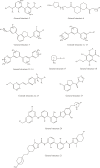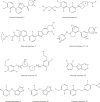Research Status and Outlook of PD-1/PD-L1 Inhibitors for Cancer Therapy
- PMID: 32982171
- PMCID: PMC7490077
- DOI: 10.2147/DDDT.S267433
Research Status and Outlook of PD-1/PD-L1 Inhibitors for Cancer Therapy
Abstract
PD-1/PD-L1 inhibitors are a group of immune checkpoint inhibitors as front-line treatment of multiple types of cancer. However, the serious immune-related adverse reactions limited the clinical application of PD-1/PD-L1 monoclonal antibodies, despite the promising curative effects. Therefore, it is urgent to develop novel inhibitors, such as small molecules, peptides or macrocycles, targeting the PD-1/PD-L1 axis to meet the increasing clinical demands. Our review discussed the mechanism of action of PD-1/PD-L1 inhibitors and presented clinical trials of currently approved PD-1/PD-L1 targeted drugs and the incidence of related adverse reactions, helping clinicians pay more attention to them, better formulate their intervention and resolution strategies. At last, some new inhibitors whose patent have been published are listed, which provide development ideas and judgment basis for the efficacy and safety of novel PD-1/PD-L1 inhibitors.
Keywords: PD-1; PD-L1; adverse events; clinical trials; immune checkpoint inhibitors; monoclonal antibody.
© 2020 Ai et al.
Conflict of interest statement
The authors report no conflicts of interest in this work.
Figures







References
Publication types
MeSH terms
Substances
LinkOut - more resources
Full Text Sources
Other Literature Sources
Medical
Research Materials

